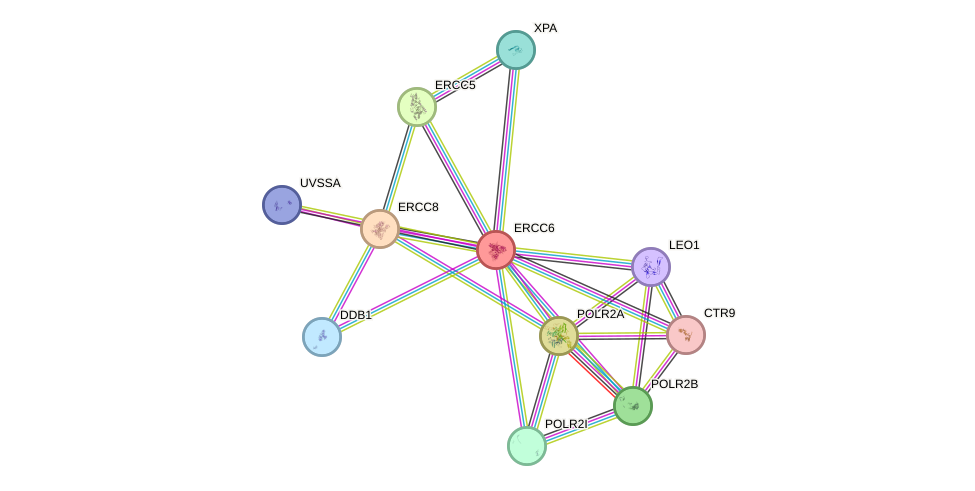GenAge entry for ERCC6 (Homo sapiens)
Gene name (HAGRID: 92)
- HGNC symbol
- ERCC6
- Aliases
- CSB; RAD26; ARMD5; CKN2
- Common name
- excision repair cross-complementation group 6
Potential relevance to the human ageing process
- Main reason for selection
- Entry selected based on evidence linking the gene product to a pathway or mechanism linked to ageing
- Description
Also known as CSB, ERCC6 is involved in DNA repair and perhaps DNA unwinding [506]. ERCC6-null mice show skin cancer predisposition, reduced growth, and neurologic dysfunction [1768]. Mice mutant for ERCC6 and XPA die before weaning and display some signs of premature ageing included stunted growth, neurological dysfunction, retinal degeneration, cachexia, and kyphosis [1934]. Mutations in the human ERCC6 gene cause Cockayne syndrome type B, which can be considered a segmental progeroid syndrome even though it is more severe than the Cockayne syndrome type A caused by mutations in ERCC8. If indeed Cockayne syndrome is premature ageing, it is likely ERCC6 plays a role in human ageing [238].
Cytogenetic information
- Cytogenetic band
- 10q11.23
- Location
- 49,454,480 bp to 49,539,123 bp
- Orientation
- Minus strand
Protein information
- Gene Ontology
-
Process: GO:0000303; response to superoxide
GO:0006283; transcription-coupled nucleotide-excision repair
GO:0006284; base-excision repair
GO:0006290; pyrimidine dimer repair
GO:0006362; transcription elongation from RNA polymerase I promoter
GO:0006366; transcription from RNA polymerase II promoter
GO:0006979; response to oxidative stress
GO:0007256; activation of JNKK activity
GO:0007257; activation of JUN kinase activity
GO:0008630; intrinsic apoptotic signaling pathway in response to DNA damage
GO:0009411; response to UV
GO:0009636; response to toxic substance
GO:0010165; response to X-ray
GO:0010224; response to UV-B
GO:0010332; response to gamma radiation
GO:0032784; regulation of DNA-templated transcription, elongation
GO:0032786; positive regulation of DNA-templated transcription, elongation
GO:0035264; multicellular organism growth
GO:0045494; photoreceptor cell maintenance
GO:0045815; positive regulation of gene expression, epigenetic
GO:0061098; positive regulation of protein tyrosine kinase activity
Cellular component: GO:0005634; nucleus
GO:0005654; nucleoplasm
GO:0005730; nucleolus
GO:0008023; transcription elongation factor complex
Hide GO termsFunction: GO:0003677; DNA binding
GO:0003678; DNA helicase activity
GO:0003682; chromatin binding
GO:0005515; protein binding
GO:0005524; ATP binding
GO:0008022; protein C-terminus binding
GO:0008094; DNA-dependent ATPase activity
GO:0030296; protein tyrosine kinase activator activity
GO:0032403; protein complex binding
GO:0047485; protein N-terminus binding
Protein interactions and network
- Protein-protein interacting partners in GenAge
- TP53, ERCC2, ERCC8, PARP1, BRCA1, RPA1, VCP, ERCC3, ERCC5, PCNA, POLD1, BAX, XPA, HDAC1, MDM2, ERCC4
- STRING interaction network
Retrieve sequences for ERCC6
Homologs in model organisms
- Danio rerio
- ercc6
- Mus musculus
- Ercc6
- Rattus norvegicus
- Ercc6
- Saccharomyces cerevisiae
- RAD26
- Schizosaccharomyces pombe
- rhp26
In other databases
- LongevityMap
- This gene is present as ERCC6
Selected references
External links
- EPD
- ORF Accession
- NM_000124
- CDS Accession
- NP_000115
- OMIM
- 609413
- HPRD
- 00596
- Ensembl
- ERCC6
- UniProt/Swiss-Prot
- ERCC6_HUMAN
- GeneCards
- ERCC6
- Entrez Gene
- 2074
- UniGene
- GenAtlas
- ERCC6
- Internet
- Search Google

